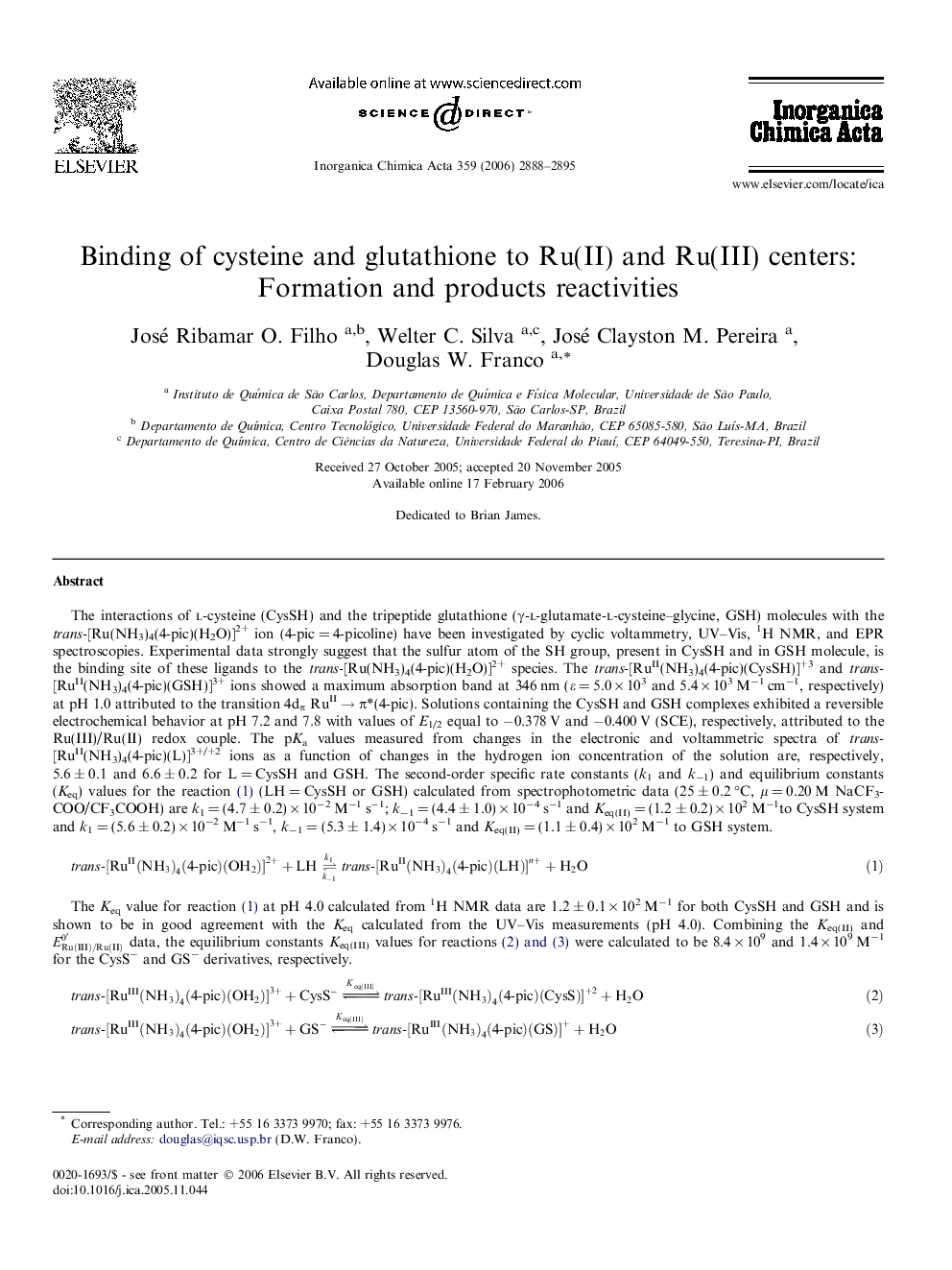| Article ID | Journal | Published Year | Pages | File Type |
|---|---|---|---|---|
| 1313030 | Inorganica Chimica Acta | 2006 | 8 Pages |
The interactions of l-cysteine (CysSH) and the tripeptide glutathione (γ-l-glutamate-l-cysteine–glycine, GSH) molecules with the trans-[Ru(NH3)4(4-pic)(H2O)]2+ ion (4-pic = 4-picoline) have been investigated by cyclic voltammetry, UV–Vis, 1H NMR, and EPR spectroscopies.Experimental data strongly suggest that the sulfur atom of the SH group, present in CysSH and in GSH molecule, is the binding site of these ligands to the trans-[Ru(NH3)4(4-pic)(H2O)]2+ species.The trans-[RuII(NH3)4(4-pic)(CysSH)]+3 and trans-[RuII(NH3)4(4-pic)(GSH)]3+ ions showed a maximum absorption band at 346 nm (ε = 5.0 × 103 and 5.4 × 103 M−1 cm−1, respectively) at pH 1.0 attributed to the transition 4dπ RuII → π*(4-pic).Solutions containing the CysSH and GSH complexes exhibited a reversible electrochemical behavior at pH 7.2 and 7.8 with values of E1/2 equal to −0.378 V and −0.400 V (SCE), respectively, attributed to the Ru(III)/Ru(II) redox couple.The pKa values measured from changes in the electronic and voltammetric spectra of trans-[RuII(NH3)4(4-pic)(L)]3+/+2 ions as a function of changes in the hydrogen ion concentration of the solution are, respectively, 5.6 ± 0.1 and 6.6 ± 0.2 for L = CysSH and GSH. The second-order specific rate constants (k1 and k−1) and equilibrium constants (Keq) values for the reaction (1) (LH = CysSH or GSH) calculated from spectrophotometric data (25 ± 0.2 °C, μ = 0.20 M NaCF3COO/CF3COOH) are k1 = (4.7 ± 0.2) × 10−2 M−1 s−1; k−1 = (4.4 ± 1.0) × 10−4 s−1 andKeq(II) = (1.2 ± 0.2) × 102 M−1 to CysSH system and k1 = (5.6 ± 0.2) × 10−2 M−1 s−1, k−1 = (5.3 ± 1.4) × 10−4 s−1 and Keq(II) = (1.1 ± 0.4) × 102 M−1 to GSH system.equation(1)trans-[RuII(NH3)4(4-pic)(OH2)]2++LH⇌k-1k1trans-[RuII(NH3)4(4-pic)(LH)]n++H2OThe Keq value for reaction (1) at pH 4.0 calculated from 1H NMR data are 1.2 ± 0.1 × 102 M−1 for both CysSH and GSH and is shown to be in good agreement with the Keq calculated from the UV–Vis measurements (pH 4.0). Combining the Keq(II) and ERu(III)/Ru(II)0′ data, the equilibrium constants Keq(III) values for reactions and were calculated to be 8.4 × 109 and 1.4 × 109 M−1 for the CysS− and GS− derivatives, respectively.equation(2)trans-[RuIII(NH3)4(4-pic)(OH2)]3++CysS-⇌Keq(III)trans-[RuIII(NH3)4(4-pic)(CysS)]+2+H2Oequation(3)trans-[RuIII(NH3)4(4-pic)(OH2)]3++GS-⇌Keq(III)trans-[RuIII(NH3)4(4-pic)(GS)]++H2OCysSH and GSH complexes are oxidized by H2O2 yielding their oxidized deprotonated analogs. The trans-[RuIII(NH3)4(4-pic)(GS)]3+ ion at pH 1.0 exhibits a ligand to metal charge transfer (λmax at 518 nm, ε ∼ 2.0 × 103 M−1 cm−1) attributed to the transition ∗S → 4dπ RuIII and a well defined EPR spectrum g⊥ = 2.27 and g∥ = 1.91 in the 2700–3800 G region.
Graphical abstractCysteine or glutathione binds to Ru(II) and Ru(III) centers through the sulfhydryl group.Figure optionsDownload full-size imageDownload as PowerPoint slide
